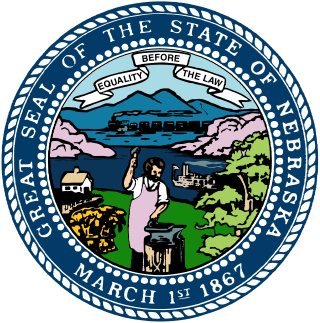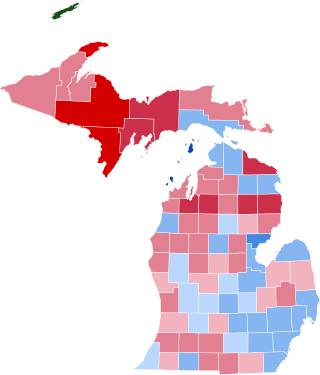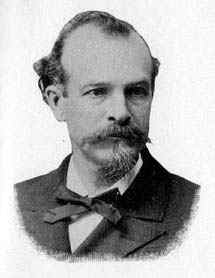| |||||||||||||||||||||
| |||||||||||||||||||||
| |||||||||||||||||||||
| Elections in Nebraska |
|---|
 |
The 1882 Nebraska lieutenant gubernatorial election was held on November 7, 1882, and featured Republican nominee Alfred W. Agee defeating Democratic nominee Jesse F. Warner as well as Greenback nominee D. P. Reynolds. [a] [1]
| |||||||||||||||||||||
| |||||||||||||||||||||
| |||||||||||||||||||||
| Elections in Nebraska |
|---|
 |
The 1882 Nebraska lieutenant gubernatorial election was held on November 7, 1882, and featured Republican nominee Alfred W. Agee defeating Democratic nominee Jesse F. Warner as well as Greenback nominee D. P. Reynolds. [a] [1]
| Party | Candidate | Votes | % | |
|---|---|---|---|---|
| Republican | Alfred W. Agee | 44,520 | 50.13 | |
| Democratic | Jesse F. Warner | 26,622 | 29.98 | |
| Greenback | D. P. Reynolds [a] | 17,656 | 19.88 | |
| Scattering | 10 | |||
| Total votes | 88,808 | 100.00 | ||
| Republican hold | ||||

Presidential elections were held in the United States on November 4, 1884. Democratic Governor Grover Cleveland of New York narrowly defeated Republican James G. Blaine of Maine. It was set apart by mudslinging and personal allegations that eclipsed substantive issues, such as civil administration change. Cleveland was the first Democrat elected president of the United States since James Buchanan in 1856, the first to hold office since Andrew Johnson left the White House in 1869, and the last to hold office until Woodrow Wilson, who began his first term in 1913. For this reason, 1884 is a significant election in U.S. political history, marking an interruption in the era when Republicans largely controlled the presidency between Reconstruction and the Great Depression.

The 1882 South Carolina gubernatorial election was held on November 7, 1882 to select the governor of the state of South Carolina. Hugh Smith Thompson was nominated by the Democrats and ran against J. Hendrix McLane, a Greenback-Labor candidate. Thompson easily won the general election and became the 81st governor of South Carolina.

The 1885 New York state election was held on November 3, 1885, to elect the governor, the lieutenant governor, the secretary state, the state comptroller, the attorney general, the state treasurer and the state engineer, as well as all members of the New York State Assembly and the New York State Senate.

The 1879 New York state election was held on November 4, 1879, to elect the governor, the lieutenant governor, the secretary state, the state comptroller, the attorney general, the state treasurer and the state engineer, as well as all members of the New York State Assembly and the New York State Senate.

The 1887 New York state election was held on November 8, 1887, to elect the Secretary of State, the State Comptroller, the Attorney General, the State Treasurer and the State Engineer, as well as all members of the New York State Assembly and the New York State Senate.

Alfred Whitman Agee was the third lieutenant governor of Nebraska, serving from 1883 to 1885 while James W. Dawes was governor.
Joseph Birdsall Reynolds was an American lawyer from Chilton, Wisconsin who served one term as a member of the Wisconsin State Assembly from Calumet County. He was elected as both a Greenback Party and Democratic candidate.

The 1974 Nebraska gubernatorial election was held on November 5, 1974, and featured incumbent Governor James Exon, a Democrat, defeating Republican nominee, state Senator Richard D. Marvel. Independent state Senator Ernie Chambers also captured 5% of the vote as a write-in candidate. This was the first gubernatorial election in Nebraska in which the nominees for Governor and Lieutenant Governor ran as a single ticket in the general election, though they were chosen in separate primary elections.

The 1884 United States presidential election in Michigan took place on November 4, 1884, as part of the 1884 United States presidential election. Voters chose 13 representatives, or electors, to the Electoral College, who voted for president and vice president.

The 1881 Wisconsin gubernatorial election was held on November 8, 1881.

The 1882 Nebraska gubernatorial election was held on November 7, 1882. Incumbent Republican governor Albinus Nance did not seek reelection. This election featured James W. Dawes, a Republican, defeating Democratic nominee J. Sterling Morton and Greenback nominee Edward P. Ingersoll.

The 1878 Nebraska gubernatorial election was held on November 5, 1878. Incumbent Republican governor Silas Garber did not seek reelection. This election featured Republican nominee Albinus Nance, the Speaker of the Nebraska House of Representatives, defeating Democratic nominee Colonel William H. Webster, a lawyer from Merrick County, Nebraska, and Greenback Party nominee Levi G. Todd, a former member of the Nebraska Territorial House of Representatives from Cass County, Nebraska.

The 1876 Nebraska gubernatorial election was held on November 7, 1876. It was the first election held under the newly adopted Nebraska Constitution of 1875. The election featured incumbent Governor Silas Garber, a Republican, defeating Democratic nominee Paren England, a lawyer from Lancaster County, Nebraska, and Greenback Party nominee Jonathan F. Gardner, former independent candidate for Governor of Nebraska in 1874.

The 1876 Nebraska lieutenant gubernatorial election was held on November 7, 1876, and featured Republican nominee Othman A. Abbott defeating Democratic nominee Miles Zentmeyer and Greenback Party nominee Allen Root.

The 1878 Nebraska lieutenant gubernatorial election was held on November 5, 1878, and featured Republican nominee Edmund C. Carns defeating Greenback and Democratic nominee Theron M. Blakely as well as the original Democratic nominee F. J. Mead who still received some votes. Originally, the Democratic party had nominated F. J. Mead for lieutenant governor. However, in late October 1878, the state central committees of the Democratic and Greenback parties met in Lincoln, Nebraska, and decided to replace F. J. Mead with Greenback candidate Theron M. Blakely on the ticket for lieutenant governor.

The 1880 Nebraska lieutenant gubernatorial election was held on November 2, 1880, and featured incumbent Nebraska Lieutenant Governor Edmund C. Carns, a Republican, defeating Democratic nominee T. J. Hamilton as well as Greenback nominee Peter Lansing and former Democratic nominee Samuel H. Calhoun. Originally, the Democratic party had nominated Calhoun for lieutenant governor. However, on October 11, 1880, Calhoun withdrew his candidacy, and the Democratic state central committee appointed T. J. Hamilton to replace him.

The 1884 Nebraska lieutenant gubernatorial election was held on November 4, 1884, and featured Republican nominee Hibbard H. Shedd defeating fusion Democratic and Greenback (Anti-Monopoly) nominee Lewis C. Pace. Incumbent Nebraska Lieutenant Governor Alfred W. Agee was renominated at the Nebraska Republican state convention, but he was defeated for the nomination by Shedd by a vote of 292 to 153 of the delegates.

The 1886 Nebraska lieutenant gubernatorial election was held on November 2, 1886, and featured incumbent Nebraska Lieutenant Governor Hibbard H. Shedd, a Republican, defeating Democratic nominee Charles J. Bowlby as well as Prohibition Party nominee E. B. Graham and National Union Party nominee M. K. Lewis.

The 1894 Nebraska lieutenant gubernatorial election was held on November 6, 1894, and featured Republican nominee Robert E. Moore defeating Populist and Democratic fusion nominee James N. Gaffin as well as Straight Democratic (anti-Populist) nominee Rodney E. Dunphy and Prohibition Party nominee Belle G. Bigelow.

The 1900 Nebraska lieutenant gubernatorial election was held on November 6, 1900, and featured Republican nominee Ezra P. Savage defeating incumbent Nebraska Lieutenant Governor Edward A. Gilbert, the Populist and Democratic fusion nominee. Other candidates who received two percent of the vote or less included Prohibition nominee Charles R. Lawson, Midroad Populist nominee Herman G. Reiter, and Social Democratic nominee David McKibben.
A. W. Agee, Aurora, Hamilton county, is an attorney.
Mr. P. B. Reynolds... is a candidate on the so-called anti-monopoly ticket for lieutenant governor....
We are informed that Mr. P. B. Reynolds, of this county, has been nominated for lieutenant governor on the anti-monopoly ticket at Hastings.
Col. J. F. Warner, the candidate for lieutenant governor...